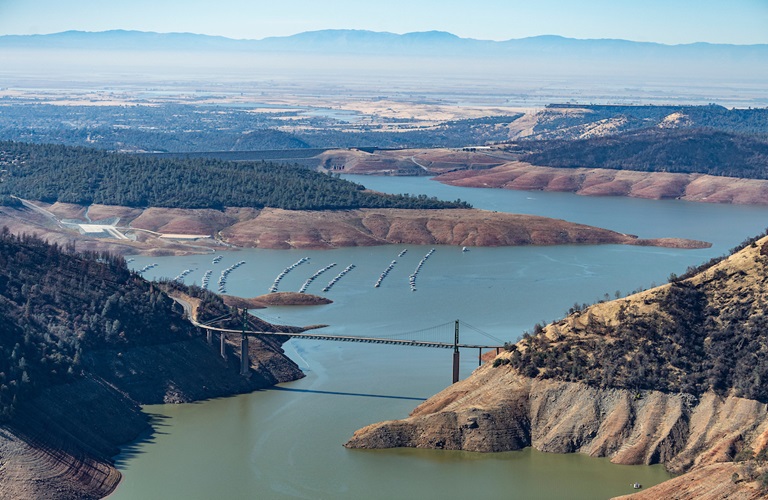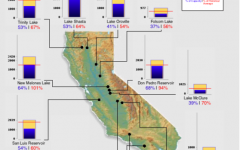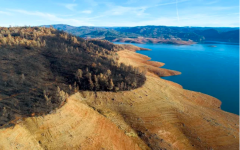
State Water Project Lake Oroville. (Photo: water.ca.gov)
Why Have No New Reservoirs Been Built Since Prop. 1 Was Passed in 2014?
Water Commission is ready, but project proponents control the schedule
By Teresa Alvarado and Matthew Swanson, February 9, 2022 8:51 am
In November 2014, California voters approved Proposition 1: The Water Quality, Supply, and Infrastructure Improvement Act. The $7.5 billion bond dedicated $2.7 billion for the public benefits of new water storage projects. Some ask, “Why have no new reservoirs been built in the seven years since?” Rest assured, there are projects in the works. All recently passed a key milestone and are moving forward.
Any large-scale water storage project is complex and requires a high degree of planning, engineering, coordination — and significant financing. The California Water Commission has actively overseen the proposed projects over the past six years to help ensure they meet statutory requirements, progress at the rate dictated by the bond legislation, and meet the public benefits promised to voters.
Proposition 1, Chapter 8 designated the Commission as the agency to administer the Water Storage Investment Program (WSIP). Investing in defined public benefits is a new approach to state financing of water storage projects. Under Proposition 1, public benefits fall into five categories: water quality improvement, flood control, emergency response, recreation, and ecosystem improvement. To qualify for the program, applicants must show that their project would advance the long-term objectives of restoring ecological health and improving water management for beneficial uses of the Sacramento-San Joaquin Delta, the crossroads of major water project operations and important habitat for endangered fish species.
In the two years after voters passed Proposition 1, the Commission drafted, adopted, and approved regulations through a transparent public process. In 2017, local water districts submitted 12 applications for the Proposition 1 funding. Commission staff and state agency experts reviewed each submission. In July 2018, the Commission decided the maximum eligible amount of bond funding that would be made available to fund the public benefits of eight proposed projects. They include a proposed reservoir in Glenn and Colusa counties that would hold water piped to it from the Sacramento River and several groundwater banks in Southern California.
Proposition 1 set a single deadline for the water storage program: By January 1, 2022, all project proponents must have completed feasibility studies, released a draft version of their environmental documents for public review, provided documentation of commitments for at least 75 percent of the non-public benefit funding, and have the Commission find that their project is feasible. Seven of the projects came before the Commission in 2021. All were found feasible and remain eligible to continue in the program.
In November 2020, one applicant withdrew from the program. The Commission redistributed a portion of the funding that project would have been eligible for among the remaining seven projects in the form of a 2.5 percent inflation adjustment. With an additional $64 million still available with the withdrawal of an original applicant, the Commission reviewed potential new projects, two of which completed the screening process in 2021. In addition, the Commission has awarded early funding totaling $116 million to help project proponents complete environmental documents and permits.
At this point, there are a total of seven projects moving forward with Proposition 1 funding that would provide 2.77 million acre-feet of water storage and significant public benefits. Under Proposition 1, before any project can receive its final award of funding, proponents must submit to the Commission completed environmental documents, permits, non-public benefit cost share contracts, and contracts with state agencies for the administration of public benefits. The Commission remains ready to award final funding as soon as these requirements are met. While there is no statutory deadline for a project to compete these requirements, the Commission does have the discretion to determine a project is not making sufficient progress and rescind its bond funding.
Each of the seven projects is different and is proceeding at different speeds. Some projects may be finished and operating within two years. Others will take longer. Since 2017, the planned implementation schedules have not changed significantly. As of this date, four projects have adopted or certified final environmental documents. Most likely to finish first is a south Sacramento County groundwater storage project called Harvest Water. Managed by the Sacramento County Regional Sanitation District, the project would use highly-treated wastewater to replace groundwater as a source of water to irrigate farmland and habitat, thus preserving groundwater. The Harvest Water Program hopes to come before the Commission for final funding later this year.
Things are getting done. Progress is being made. The Commission is carrying out the voters’ intent. We are anxious to fund the projects once the statutory requirements have been met and we look forward to seeing these projects deliver the public benefits associated with new water storage capacity so vitally needed in our state.
To find out more information on the WSIP projects and to view their projected timelines, visit cwc.ca.gov/Water-Storage.
- Why Have No New Reservoirs Been Built Since Prop. 1 Was Passed in 2014? - February 9, 2022








The bios at the end of this article sound like a couple of SJW leftists. Take this article with a grain of salt.
All she did was lay out a timeline, ignoring that a 10 year timeline to do paperwork is ridiculous. I’ll grant it all can’t be done at the same time, and things take time, but just looking at the last part, it has been 3 years (2021) since the state was ready to provide funding but paperwork is still not in order. All this article does is highlight the bureaucratic nightmare that is California.
This sounds like the high speed rail boondoggle. Squander money for years, without any actual progress.
Give back our money ????????????
How many Bills and Props do we still get charged for ?
Another group of unelected, appointed do-nothings:
https://www.breitbart.com/local/2018/02/13/prop-1-california-water-commission-kills-all-12-proposed-reservoirs/
Glaciers move faster than these bozos… tie up all the “water works” for 20 years, while paying themselves handsomely to oversee all this red-tape and “environmental impact studies”, blah blah blah and then drain the reservoirs to bankrupt the farmers and raise food prices so that the Chinese can buy up the land on the cheap… or Bill Gates (same thing)
That’s why they didnt name all the originally proposed projects.
Good thing we won’t have a water supply summer this summer after this winter’s drought.
Wait. WHAT????
What the heck has happened to The California Globe~!!????? These two “news” writers are both “environmentalists”, the same folks who have Utterly Destroyed over One Million Acres of Farms, Ranches, Orchards, & Vineyards in our Once-Hugely-Productive Great Central Valley~!!!!!! These environmentalists have Destroyed-by-Monster-Lawsuits MASSIVE Amounts of farmland, and Water Storage~!!!!!!!!!!!! All of these Water-Starvation ‘plans’ put into action as The Criminal Organization known as The California Water Resources Control Board has, (For Many Years), aided & abetted this MASSIVE Destruction of those Water-Starved-to-Death farms in The Great Central Valley~!!!! All, while viciously dumping Trillions of gallons of Our Water Uselessly into the Sea~!!! Sorry for my upset-ness~!!!
“These two “news” writers are both “environmentalists”, ….”
Exactly, Mike. And now we know who they are and what they’re doing. Let’s have Gavin Newsom do the same and write an article for the Globe. I think we would ALL love to have a little give and take with the governor.
They have been sitting on Sites reservoir for going on 30 years. “Studies”started in 1996. My guess is they are slow walking because they spent the money elsewhere.
All this article tells me is that California is a bureaucratic nightmare, controlled by powerful environmentalists. This is now January 2025, and NOT A SINGLE WATER STORAGE PROJECT HAS BEEN COMPLETED! We are the most mismanaged state in the nation, in my opinion.